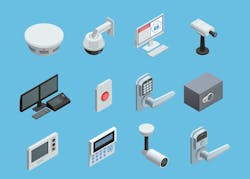There’s no denying the Internet of Things (IoT) is here to stay. Consumers are purchasing more and more connected devices every year, which has led to increased demand for the same level of simplicity and ease of technological integration within enterprises.
IoT is quickly moving from concept to reality and will create many new possibilities for organizations in every industry to increase process efficiency and profitability. Despite being in its infancy, the convergence between different IoT building solutions is already solving business challenges and changing day-to-day operations.
In the physical security space, we’ve seen the rapid rise of IP, which in many ways has paved the way for IoT. Whether it’s video, access control or intruder alarms, IP is now considered the industry standard and best way to ensure interoperability. IoT promises to further connect these once disparate systems and enable users to ensure the security of their facilities.
The ways in which IoT will be used within an organization’s security are endless as new possibilities are constantly being realized. From easily managing employee door access to evaluating traffic flows for planning or scheduling purposes, IoT will expand enterprise security capabilities and provide greater ROI for systems far into the future.
It’s easy to see that IoT will soon be a part of any industry where technology is a large component. The benefits seem endless and consumers are demanding the convenience. But it’s not as easy as “plug and play.” There are a number of pitfalls and security concerns that need to be addressed in order to remain efficient and secure, both of which are possible, but require a proper depth of knowledge and some strategic planning.
The Advantages of IoT in Security
Just as IP technology has allowed for the integration of security cameras to door locks and alarms, IoT will follow a similar trajectory in the years to come. This will enable tighter integration between security systems and allow for automation without the need for human-to-human or human-to-computer interaction.
Advanced connectivity of devices, systems and services will make monitoring individual events almost effortless. Interconnected devices will easily communicate the data needed to allow other devices to automatically take necessary actions in given scenarios. Camera sensors will play a key role in this automation, as they become the “eyes” of the entire operation. Down the road these same cameras could also improve the performance of other building devices through shared data.
Overall, IoT has the promise to make securing buildings and managing everyday operations easier and more efficient. For example, managing employee access to specific doors and areas within a building can be a hassle if key cards are lost, stolen, or if an employee leaves the company. With connected key cards and electrical locks, this process will become much more efficient when there’s a need for locks or keys to be deactivated and reset.
IP cameras will continue to be used to provide oversight of facilities and warehouse environments. Additionally, they can be used to better understand how spaces are being utilized within an enterprise to help facility managers plan for expansion. Between traffic patterns and area usage, security professionals will have an influx of data that will help buildings become ‘smarter.’
The tighter integration made possible by IoT will mean expanded capabilities and greater security system fallbacks that allow enterprises to easily meet security objectives, while minimizing the amount of security personnel on staff and increasing the buildings overall efficiency.
The Challenges of IoT
The most significant challenge that comes with the proliferation of IoT is maintaining system security. If a hacker infiltrates a network with many systems connected to it, the entire enterprise is immediately exposed. Vulnerability in one device leaves an entire system open for attack, which could lead to invasions of privacy and loss of control of an entire network of devices.
Another major challenge of IoT in the security industry is getting all systems set up on a common IP network. This is the first step toward advanced connectivity. From there, every function will have its own components and applications that will operate internally, but won’t necessarily integrate with each other.
Integrating these stand-alone components and eliminating silos will then be the biggest hurdle to achieving advanced connectivity. Moving from analog to digital is an important step, but making sure all of your devices and building components are communicating is integral to a highly functional network of systems. Largely driven by consumer products such as Apple’s HomeKit initiative and the Amazon Echo, developers are starting to create common standards that will make connecting these devices easier, but it will still take a few years before we’re there. .
Additionally, enterprises must consider the IT skills of their employees when moving toward advanced connectivity. Since IoT is the combination of several connected components, it requires advanced skills and IT knowledge to integrate the IoT platform with enterprise applications. This is especially true when incorporating security, identity and operational applications. Hiring employees with IoT experience or training existing employees may be necessary. If internal resources are not available, enterprises may need to partner with experienced consultants in order to realize the full breadth of their systems’ capabilities.
Preparing for Advanced Connectivity
As enterprises establish their networks and prepare for the future, many factors should be considered, including how their network will be used. In order to plan the network according to where users will connect from, human traffic flows and areas where people congregate should be evaluated. Employee mobility needs should also be addressed if employees often move throughout the building while needing the same level of access to the network. If so, wireless controllers may be a good way to ensure users don’t get stuck on access points and are allowed to roam freely.
User devices must also be factored into this equation. Bring your own device (BYOD) has become standard for most enterprise environments and it’s important to deliver the same level of support and access to any device regardless of manufacturer or operating system. Having more devices on the network also drives the requirements for an even more robust network that can handle the workload.
The amount of devices and the current demand for data should be discussed when determining the number of secure access points required. Future predictions of demand should also be accounted for. These decisions can be made internally but if you’re worried about the complexity of some of these systems, a company or consultant with expertise should be sought out.
Either way, it’s advised to develop a solid plan of attack prior to installation. But fortunately most networks are adaptable and can evolve and change over time. While there may be some initial frustration, networks can be easily expanded to include additional access points or switches to accommodate higher demand and more locations. This is also part of the ongoing monitoring and management of a network to ensure it continues to meet the needs of an organization.
It’s also important to map out where you will need different types of connections. Of course wireless connections are necessary for most users but wired connections can be beneficial when used properly. Stationary office spaces for example are a great place for wired connections because of their consistency and reliability. Wireless connectivity outside office walls should also be a consideration as more workers are looking to take advantage of open environments, especially patios and outdoor communal spaces.
Looking Ahead
Although all of the advanced capabilities surrounding IoT have yet to be fully realized within the security industry, the demand for connected devices by systems integrators and end-users is apparent. The convergence of IoT, sensors and analytics is already creating new and exciting opportunities for industries ranging from retail to transportation, and it’s only a matter of when for the security industry.
As this transformation continues across sectors, the security world needs to start thinking of intelligent ways of implementing the technology while also keeping their buildings and occupants safe. There isn’t a global IoT standard yet but several organizations are working to develop one for many technology-based industries. In the meantime, it’s in your best interest to utilize technologies that are as close to universal and brand agnostic as possible. This will save you the headache of having to redo your entire network in a few years.
Despite the risks, the benefits of using IoT devices within the security industry are undeniable. Enterprises will experience drastic improvements in process efficiency and profitability, while end-users will benefit from increased functionality, interoperability and ease of use.
IoT has reached a tipping point and can no longer be ignored within the security industry and beyond. As we enter this new phase of security industry innovation, it will be imperative for enterprises to consider IoT when planning new networks or expansions.
About the Author: Jeffrey Curtis is responsible for the management and day-to-day operations of Luxul. This includes generating the company’s revenue growth through the development and management of Luxul’s sales, marketing and support organizations.


